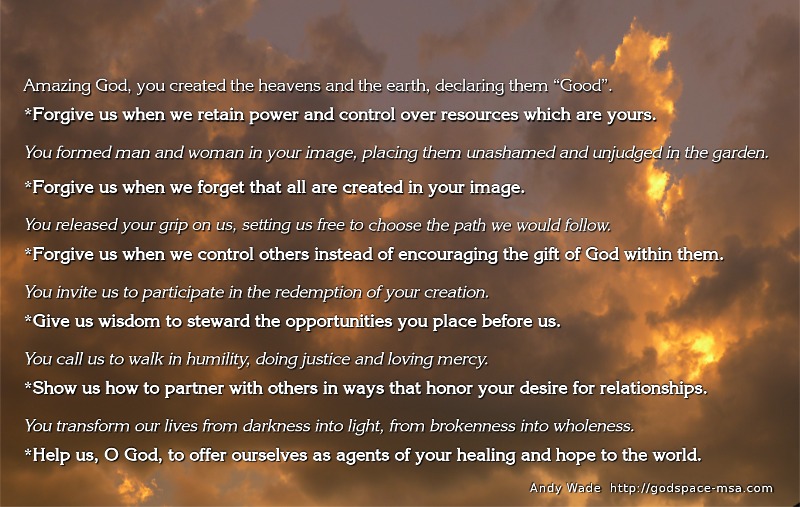By Andy Wade –
Our Lenten journey is over. We’ve navigated the dark places and walked through the events of Holy Week. We have seen the resurrection. After waiting 40 days to celebrate, our temptation is to jump right in to resurrection – to it’s time to party! “He is risen! He is risen, indeed!”
The problem comes when we embrace the resurrection while forgetting the journey that brought us there. To fully practice resurrection I need to embrace all that came before. To live into the truth of resurrection, the fullness of this reality, is more than a mental exercise. It involves my entire being… in the context of the whole creation around me.
In the excitement of the resurrection it’s easy to forget the bigger reality beyond “personal salvation”. Put in the context of Jesus’ own life and words, however, jumping to that sole conclusion is done at the cost of missing the fullness of what God has offered. So what’s really going on?
Jesus enters Jerusalem humbly riding on a donkey (coming in peace). The people are shouting triumphant praise; here comes their conquering king! But their idea of how this would happen was way off base. Along the way Jesus pauses, weeping and looking out over Jerusalem, and reflects, “If you, even you, had only known on this day what would bring you peace—but now it is hidden from your eyes.” Immediately after entering the city Jesus goes into the temple and drives out those who had turned the temple courts into a holiday bazaar.
This past Palm Sunday I was struck by this contrast; the people recognize that Jesus is some kind of king who will shake things up, perhaps even the Messiah! But the fullness of what God is up to in Jesus is somehow hidden from their eyes. His disruption of temple business at the height of Israel’s holy season is another indictment of just how much they didn’t understand.
These things, and so much more, give me pause. I want to rush to resurrection. Like those following Jesus into Jerusalem that Palm Sunday I want to say, “I get it!” and start living into my meager understanding. But if Lent and Holy Week have taught me anything, it’s just how much I don’t understand.
If the blindspot of Jesus’ followers that Palm Sunday was believing that he was coming as a conquering military king to overthrow the Romans, perhaps our blindspot in modern western Christianity is believing that Jesus came merely to save individuals from sin for heaven. “Do you know Jesus as your personal Lord and Savior?” “Have you prayed the ‘sinners prayer’?”
For me, the Lenten journey is a life-long process, one of walking with others, indeed the whole creation, in following the “pioneer and perfecter of our faith” (Heb 12.2). Life is kind of a Lenten journey of resurrection living – two realities commingled, as we attempt to live into the mystery of God and God’s purposes for all creation.
Salvation in Jesus is not just some theological construct of right belief, as if belief and actions could be divided. Salvation is rather a mind-blowing expression of God’s intention to make all things flourish as God brings all things together – things in heaven and things on earth – in Christ Jesus. (Eph. 1.9-10, Col. 1.19-21, Rom. 8.20-24).
This reality is driven deeper by exploring the meaning of two central words, peace and salvation, or rather, Shalom and sozo. Shalom, which we narrowly translate as “peace”, and sozo, the word we normally translate as “saved”, have much broader implications than our simple English rendering can grasp.
These two words are central to the work of God throughout history and in the world through the cross and resurrection. Both words attempt to contain the complete desire of God for all creation: wholeness, harmony, restoration, rescue, freedom, unity, and so much more. The Year of Jubilee, commanded by God and proclaimed by Jesus, represented the actions behind those words. And the resurrection proved that the time of jubilee had arrived.
Practicing resurrection, our theme on Godspace this Easter season, requires that I embrace all of these things. Before I act, I must listen. I must hear the song of shalom and sozo and jubilee as it rings through the ages and bursts forth from the empty tomb. I must hear its song not only as deeply personal, but also as a tune filling the whole creation. I cannot practice resurrection alone.
So I invite you to join me in listening, drinking deeply from the well of shalom made possible in Jesus. I invite you to look around at your family, friends, neighborhood, city and world and ask what shalom and sozo and jubilee mean for them. And ponder the creation: the donkey that carried Jesus, the wine and the bread – gifts from the earth, even the soil that soaked up the blood of the one who died to reconcile all things to himself. Then, perhaps, we’ll be ready to truly live into the profound purpose of resurrection in ways that release the fullness of God’s love into the world.

